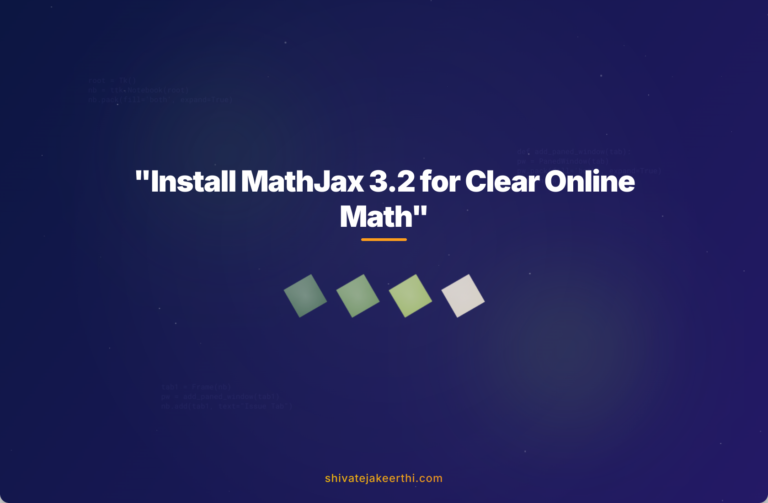If you’ve ever tried learning mathematics online, you’ve probably noticed how tricky it can be to display mathematical equations properly. Regular text formatting just doesn’t cut it—fractions can look strange, and symbols might not appear correctly. That’s where MathJax comes in—it’s a simple, efficient tool designed specifically for showing beautiful, clear math expressions online, without requiring any fancy software downloads. In this post, we’ll show you exactly how to install MathJax 3.2 effortlessly either via GitHub or a CDN (Content Delivery Network)—no file downloads are needed!
What Exactly is MathJax?
MathJax is a powerful JavaScript library that lets webpages accurately display mathematical equations and notations. It accepts popular math markup languages like LaTeX, MathML, and ASCII Math, converting them neatly into visually appealing math expressions in your browsers.
This makes MathJax a favorite choice for teachers, students, and mathematicians who regularly share mathematical content online. Some key benefits include:
- Improved readability: Equations become clear and readable, matching textbook quality.
- Accessibility: MathJax supports screen readers and assistive technologies.
- Platform simplicity: It works across all web browsers, smartphones, and desktop computers.
Why Upgrade to MathJax 3.2?
MathJax 3.2 introduces several significant enhancements compared to its previous versions. It now loads faster and renders equations even more precisely, improving overall site performance and user experience.
Other notable improvements include better support for assistive technologies, smoother HTML outputs, and quicker compatibility with browsers and mobile devices. Upgrading ensures your math content remains future-proof, providing readers with the best interactive mathematical experience.
To see exactly what MathJax offers for JavaScript enthusiasts, you can read some of our JavaScript articles in the JavaScript category and see how libraries like MathJax blend seamlessly with other JavaScript tools.
Getting Started: Installation Methods
When installing MathJax for your website, you’ve got two simple routes:
- GitHub: A flexible, updated hub where MathJax is actively maintained and continuously improved.
- CDN (Content Delivery Network): Easily connect your site to MathJax without storing the files yourself, ideal for beginners who prefer simplicity.
Here’s a handy step-by-step breakdown of both methods without any file downloads needed:
Installing MathJax via GitHub (Without Downloads)
Installing via GitHub involves linking directly to MathJax’s official source repository online. Here’s how you do it in just two quick steps:
- Open your HTML file and add this script tag within the <head> section:
<script src="https://cdn.jsdelivr.net/gh/mathjax/MathJax@3/es5/tex-mml-chtml.js"></script>
- Now you can start using MathJax tags anywhere on your page. Try the following example within your page body:
\[
E = mc^2
\]
This GitHub-hosted method ensures you’ll always get the recent MathJax updates directly, but remember your site might rely on GitHub’s server availability.
Pros of GitHub method:
- Access to the most updated code.
- No need for manual file storage.
Cons of GitHub method:
- Your site’s math support depends on GitHub availability.
- Slightly challenging for complete beginners unfamiliar with repositories.
Installing MathJax via CDN
A CDN simplifies your MathJax installation even further. It distributes MathJax via high-speed global servers, making load speeds incredibly fast and reliable.
Here’s exactly how to set it up using the popular Cloudflare CDN:
- Add this single line into your HTML’s <head> section:
<script src="https://cdnjs.cloudflare.com/ajax/libs/mathjax/3.2.2/es5/tex-mml-chtml.min.js" integrity="sha512-57gkfEUSVFDV62+rQaitl7dc/RZ/EbfnPzJ4zRISwUW72tvJU5T8zFmi194CytlhOET01ym4uvijEUnHmc7BTQ==" crossorigin="anonymous" referrerpolicy="no-referrer"></script>
- Add math equations directly wherever you want:
\[
a^2 + b^2 = c^2
\]
And just like that, you’re running MathJax from a powerful global CDN instantly.
Pros of CDN method:
- Easy to set up.
- Reliably fast global loading speeds.
Cons of CDN method:
- Less control over version management compared to GitHub.
- External dependencies may affect performance temporarily.
Tips for Beginners (No Coding Experience Needed)
If math and code have intimidated you before, here are easy-to-follow MathJax installation tips to ease you in smoothly:
- Just copy-paste the provided codes carefully within your website’s HTML file exactly where indicated.
- Always ensure your editor supports saving and displaying HTML files.
- Avoid modifying integrity or crossorigin attributes in CDN scripts—they authenticate your site’s MathJax safely.
Common pitfalls to avoid:
- Double-checking your HTML tags and URLs to avoid typos or broken links.
- Using incorrect JavaScript paths (Copy-paste carefully!).
Using MathJax for Mathematics Learning & Practice
MathJax beautifully renders many complex mathematical equations online, whether algebraic, calculus-based, or geometry problems. For instance, to display the quadratic equation:
\[
x = \frac{-b \pm \sqrt{b^2 - 4ac}}{2a}
\]
Simply include the above MathJax code anywhere in your HTML file, and MathJax handles the readability seamlessly.
For practice purposes, resources like Khan Academy and Mathematics Stack Exchange frequently use MathJax for tutorials and discussions. Exploring those examples can boost confidence in MathJax usage.
Integrating MathJax with R Language
If you’re familiar with R programming language, MathJax integrates beautifully with R Markdown for dynamic mathematical presentations and computations. Simply use the following structure in your R Markdown document:
$$
\mu = \frac{1}{n}\sum_{i=1}^n x_i
$$
RStudio automatically renders this using MathJax, opening doors for advanced data visualization projects and math-heavy computational tasks.
Ready to Bring Your Mathematics Clearly Online?
Whether you’re a teacher, student, or math enthusiast, installing MathJax 3.2 ensures your mathematical content is easy-to-read, beautiful, and accessible. Following this guide, you will have MathJax installed quickly and effortlessly even without software downloads.
Have you already tried MathJax? Which features do you appreciate the most? Or do you have other methods or tips to share? We’d love to hear your experiences below!



0 Comments